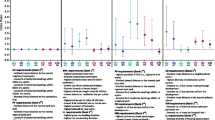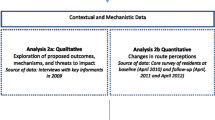Abstract
Objective
Interventions that address the built environment present an opportunity to affect behaviours such as physical activity. The purpose of this study was to evaluate a community walking map developed for eight neighbourhoods in the City of Edmonton (COE).
Method
A walking map developed in partnership with the COE’s Walkable Initiative was distributed to 11,994 households across eight neighbourhoods in July 2010. In total, 149 respondents completed an online follow-up survey that assessed the effectiveness of the walking maps in influencing physical activity.
Results
Of the 149 respondents, 89 (59.7%) reported that they had received a copy of the map, and 60 (40.2%) reported that they had not. Of those who had a copy, 76.4% (n=68) indicated that the routes and destinations on the map encouraged them to walk more in the community, 64.0% (n=57) stated they would walk more often to get to destinations, and 55.1 % (n=49) indicated they would walk more often for physical activity or exercise as a result of having a copy of the map. Finally, 91.0% (n=81) stated that they found the map to be useful, as it provided walking routes (60/81, 74.1 %,) and places to go in the community (57/81, 70.4%). Of those who did not receive a copy, 95.0% (n=57) indicated that they would use a community walking map.
Conclusion
This evaluation demonstrated that a community walking map was a valuable tool for not only encouraging walking for physical activity but also motivating individuals to explore their communities and visit local community destinations.
Résumé
Objectif
Les interventions sur le milieu bâti sont des occasions d’influencer les comportements comme l’activité physique. Notre étude visait à évaluer une carte de marche dans la communauté élaborée pour huit quartiers de la ville d’Edmonton.
Méthode
Une carte de marche, élaborée en partenariat avec le projet Walkable Initiative d’Edmonton, a été envoyée à 11 994 ménages de huit quartiers en juillet 2010. En tout, 149 répondants ont rempli un questionnaire de suivi en ligne évaluant l’influence de ces cartes sur leur niveau d’activité physique.
Résultats
Sur les 149 répondants, 89 (59,7 %) ont dit avoir reçu un exemplaire de la carte, et 60 (40,2 %) ont dit ne pas en avoir reçu. De ceux qui en avaient un exemplaire, 76,4 % (n=68) ont indiqué que les trajets et les points d’intérêt sur la carte les incitaient à marcher davantage dans la communauté, 64 % (n=57) ont dit qu’ils se rendaient plus souvent à leurs destinations à pied, et 55,1 % (n=49) ont indiqué qu’ils marchaient plus souvent pour faire de l’activité physique ou de l’exercice depuis qu’ils avaient la carte. Enfin, 91 % (n=81) ont dit avoir trouvé la carte utile, car elle propose des trajets (60/81, 74,1 %) et des endroits à visiter dans la communauté (57/81, 70,4 %). De ceux qui n’avaient pas reçu la carte, 95 % (n=57) ont indiqué qu’ils se serviraient d’une carte de marche dans la communauté.
Conclusion
Cette évaluation montre qu’une carte de marche dans la communauté est un outil précieux non seulement pour encourager la marche en tant qu’activité physique mais pour inciter les gens à explorer leur communauté et à visiter des points d’intérêt locaux.
Similar content being viewed by others
References
Burke NM, Chomitz VR, Rioles NA, Winslow SP, Brukilacchio LB, Baker JC. The path to active living: Physical activity through community design in Somerville, Massachusetts. Am J Prev Med 2009;37(6 Suppl 2):S386–94.
van Sluijs EM, McMinn AM, Griffin SJ. Effectiveness of interventions to promote physical activity in children and adolescents: Systematic review of controlled trials. BMJ 2007;335(7622):703.
Warburton DE, Nicol CW, Bredin SS. Health benefits of physical activity: The evidence. CMAJ 2006;174(6):801–9.
Vanasse A, Demers M, Hemiari A, Courteau J. Obesity in Canada: Where and how many? Int J Obes (Lond) 2006;30(4):677–83.
Katzmarzyk PT, Gledhill N, Shephard RJ. The economic burden of physical inactivity in Canada. CMAJ 2000;163(11):1435–40.
Moudon AV, Lee C, Cheadle AD, Garvin C, Rd DB, Schmid TL, Weathers RD. Attributes of environments supporting walking. Am J Health Promot 2007;21(5):448–59.
Hooker SP, Cirill LA, Wicks L. Walkable neighbourhoods for seniors: The Alameda County experience. J Appl Gerontol 2006;26(2):157–81.
Dannenberg AL, Cramer TW, Gibson CJ. Assessing the walkability of the workplace: A new audit tool. Am J Health Promot 2005;20(1):39–44.
Moudon AV, Lee C. Walking and bicycling: An evaluation of environmental audit instruments. Am J Health Promot 2003;18(1):21–37.
McLeroy KR, Norton BL, Kegler MC, Burdine JN, Sumaya CV. Community-based interventions. Am J Public Health 2003;93(4):529–33.
Brownson RC, Baker EA, Boyd RL, Caito NM, Duggan K, Housemann RA, et al. A community-based approach to promoting walking in rural areas. Am J Prev Med 2004;27(1):28–34.
Walkable Edmonton. First Steps: Walkable Edmonton Committee 2008 Annual Report, 2008. Available at: https://doi.org/www.edmonton.ca/for_residents/WalkableEdmontonAnnualReport2008.pdf (Accessed October 8, 2010).
City of Edmonton. Neighbourhood Profiles, 2010. Available at: https://doi.org/www.edmonton.ca/for_residents/neighbourhoods/ (Accessed October 25, 2010).
Cooper C. Successfully changing individual travel behavior: Applying community-based social marketing to travel choice. J Transportation Research Board 2007;2021(11):89–99.
Mutrie N, Carney C, Blarney A, Crawford F, Aitchison T, Whitelaw A. “Walk in to work out”: A randomised controlled trial of a self help intervention to promote active commuting. J Epidemiol Community Health 2002;56(6):407–12.
Pereira MA, Kriska AM, Day RD, Cauley JA, LaPorte RE, Kuller LH. A randomized walking trail in postmenopausal women: Effects on physical activity and health 10 years later. Arch Intern Med 1998;158:1695–701.
Williams DM, Matthews CE, Rutt C, Napolitano MA, Marcus BH. Interventions to increase walking behavior. Med Sci Sports Exerc 2008;40(7 Suppl):S567–73.
Miller EK, Scofield JL. Slavic Village: Incorporating active living into community development through partnerships. Am J Prev Med 2009;37(6 Suppl 2):S377–85.
Pucher J, Dijkstra L. Promoting safe walking and cycling to improve public health: Lessons from the Netherlands and Germany. Am J Public Health 2003;93(9):1509–16.
Horowitz CR, Robinson M, Seifer S. Community-based participatory research: From the margin to the mainstream. Circulation 2009;119:2633–42.
Author information
Authors and Affiliations
Corresponding author
Additional information
Acknowledgements: Funding for this project was provided by the Heart and Stroke Foundation of Canada in partnership with the Canadian Institutes of Health Research. I. Hosier is a community partner who was employed by the walking map initiative
Conflict of Interest: None to declare
Rights and permissions
About this article
Cite this article
Nykiforuk, C.I.J., Nieuwendyk, L.M., Mitha, S. et al. Examining Aspects of the Built Environment: An Evaluation of a Community Walking Map Project. Can J Public Health 103 (Suppl 3), S67–S72 (2012). https://doi.org/10.1007/BF03403838
Published:
Issue Date:
DOI: https://doi.org/10.1007/BF03403838




